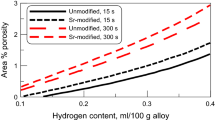Abstract
The tensile response, the low cycle fatigue (LCF) resistance, and the creep behavior of an aluminum (Al) cast alloy are studied at ambient and elevated temperatures. A non-contact real-time optical extensometer based on the digital image correlation (DIC) is developed to achieve strain measurements without damage to the specimen. The optical extensometer is validated and used to monitor dynamic strains during the mechanical experiments. Results show that Young’s modulus of the cast alloy decreases with the increasing temperature, and the percentage elongation to fracture at 100 °C is the lowest over the temperature range evaluated from 25 °C to 300 °C. In the LCF test, the fatigue strength coefficient decreases, whereas the fatigue strength exponent increases with the rising temperature. The fatigue ductility coefficient and exponent reach maximum values at 100 °C. As expected, the resistance to creep decreases with the increasing temperature and changes from 200 °C to 300 °C.
Similar content being viewed by others
References
OKAYASU, M., OHKURA, Y., TAKEUCHI, S., TAKASU, S., OHFUJI, H., and SHIRAISHI, T. A study of the mechanical properties of an Al-Si-Cu alloy produced by various casting process. Materials Science and Engineering: A, 543, 185–192 (2012)
HUANG, Z. W., WANG, Z. G., ZHU, S. J., YUAN, F. H., and WANG, F. G. Thermomechan- ical fatigue behavior and life prediction of a cast nickel-based superalloy. Materials Science and Engineering: A, 432, 308–316 (2006)
FEKETE, B. and TRAMPUS, P. Isothermal and thermal mechanical fatigue of VVER-440 reactor pressure vessel steels. Journal of Nuclear Materials, 464, 394–404 (2015)
DIETRICH, L. and RADZIEJEWSKA, J. The fatigue damage development in a cast Al-Si-Cu alloy. Materials and Design, 32(1), 322–329 (2011)
MAYER, H., PAPAKYRIACOU,M., ZETTL, B., and STANZL-TSCHEGG, S. Influence of poros- ity on the fatigue limit of die cast magnesium and aluminum alloys. International Journal of Fatigue, 25(3), 245–256 (2003)
ELHADARI, H. A., PATEL, H. A., CHEN, D. L., and KASPRZAK, W. Tensile and fatigue prop- erties of a cast aluminum alloy with Ti, Zr and V additions. Materials Science and Engineering: A, 528(28), 8128–8138 (2011)
OVONO, D. O., GUILLOT, I., and MASSINON, D. Study on low-cycle fatigue behaviors of the aluminum cast alloys. Journal of Alloys and Compounds, 452(2), 425–431 (2008)
ASTM E606. Standard Test Method for Strain-Controlled Fatigue Testing, American Society for Testing and Materials, West Conshohocken, PA(2012)
XIONG, J. J., WU, Z., and GAO, Z. T. Generalized fatigue constant life curve and two- dimensional probability distribution of fatigue limit. Applied Mathematics and Mechanics (English Edition), 23(10), 1188–1193 (2002) https://doi.org/10.1007/BF02437667
KANCHANOMAI, C. and MUTOH, Y. Temperature effect on low cycle fatigue behavior of Sn-Pb eutectic solder. Scripta Metallurgica, 50(1), 83–88 (2004)
TAO, G. and XIA, Z. H. A non-contact real-time strain measurement and control system for multiaxial cyclic/fatigue tests of polymer materials by digital image correlation method. Polymer Testing, 24(7), 844–855 (2005)
ZHANG, S. Q., MAO, S. S., AROLA, D., and ZHANG, D. S. Characterization of the strain- life fatigue properties of thin sheet metal using an optical extensometer. Optics and Lasers in Engineering, 60, 44–48 (2014)
WU, R., KONG, C., LI, K., and ZHANG, D. S. Real-time digital image correlation for dynamic strain measurement. Experimental Mechanics, 56(5), 833–843 (2016)
KENNEDY, J. and EBERHART, R. Particle swarm optimization. Proceedings of IEEE International Conference on Neural Networks, IEEE, Perth, WA(1995)
XU, J. B., PO, L. M., and CHEUNG, C. K. Adaptive motion tracking block matching algorithms for video coding. IEEE Transactions on Circuits and Systems for Video Technology, 9(7), 1025–1029 (1999)
PO, L. M., NG, K. H., CHEUNG, K. W., PO, L. M., NG, K. H., CHEUNG, K. W., WONG, K. M., UDDIN, Y. M. S., and TING, C. W. Novel directional gradient descent searches for fast block motion estimation. IEEE Transactions on Circuits and Systems for Video Technology, 19(8), 1189–1195 (2009)
BARRETT, P. R., AHMED, R., MENON, M., and HASSAN, T. Isothermal low-cycle fatigue and fatigue-creep of Haynes 230. International Journal of Solids and Structures, 88-89, 146–164 (2016)
MAHIDHARA, R. and MUKHERJEE, A. High temperature flow and failure process in an Al- 13wt% (w(Al)=13%) Si eutectic alloy. Journal of Materials Science, 32(3), 809–814 (1997)
SHENG, X. P., SHENG, G. X., CHEN, L. X., and YANG, L. Investigation on gradient-dependent nonlocal constitutive models for elasto-plasticity coupled with damage. Applied Mathematics and Mechanics (English Edition), 26(2), 218–233 (2005) https://doi.org/10.1007/BF02438245
ZAMANI, M., SEIFEDDINE, S., and JARFORS, A. High temperature tensile deformation be- havior and failure mechanisms of an Al-Si-Cu-Mg cast alloy—–the microstructure scale effect. Materials and Design, 86, 361–370 (2015)
ZHANG, S. and XIONG, D. Crack propagation in the power-law nonlinear viscoelastic material. Applied Mathematics and Mechanics (English Edition), 18(11), 1065–1071 (1997) https://doi.org/10.1007/BF00132800
Author information
Authors and Affiliations
Corresponding author
Additional information
Citation: ZHANG, S. Q., ZHANG, Y. C., CHEN, M., WANG, Y. J., CUI, Q., WU, R., AROLA, D., and ZHANG, D. S. Characterization of mechanical properties of aluminum cast alloy at ele- vated temperature. Applied Mathematics and Mechanics (English Edition), 39(7), 967–980 (2018) https://doi.org/10.1007/s10483-018-2349-8
Project supported by the National Natural Science Foundation of China (Nos. 11372173, 11672347, and 11727804) and the Science and Technology Development Foundation of Shanghai Automobile Industry (No. 1514)
Rights and permissions
About this article
Cite this article
Zhang, S., Zhang, Y., Chen, M. et al. Characterization of mechanical properties of aluminum cast alloy at elevated temperature. Appl. Math. Mech.-Engl. Ed. 39, 967–980 (2018). https://doi.org/10.1007/s10483-018-2349-8
Received:
Revised:
Published:
Issue Date:
DOI: https://doi.org/10.1007/s10483-018-2349-8
Keywords
- mechanical behavior
- aluminum (Al) cast alloy
- elevated temperature
- digital image correlation (DIC)
- optical extensometer




